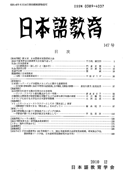Volume 175
Displaying 1-12 of 12 articles from this issue
- |<
- <
- 1
- >
- >|
FEATURED ISSUE: Diversity of Career Formation Enabled by Japanese Language Learning
-
2020Volume 175 Pages 1-3
Published: April 25, 2020
Released on J-STAGE: April 26, 2022
Download PDF (226K)
Featured Articles
-
2020Volume 175 Pages 4-18
Published: April 25, 2020
Released on J-STAGE: April 26, 2022
Download PDF (539K) -
2020Volume 175 Pages 19-33
Published: April 25, 2020
Released on J-STAGE: April 26, 2022
Download PDF (631K) -
2020Volume 175 Pages 34-49
Published: April 25, 2020
Released on J-STAGE: April 26, 2022
Download PDF (564K) -
2020Volume 175 Pages 50-64
Published: April 25, 2020
Released on J-STAGE: April 26, 2022
Download PDF (585K) -
2020Volume 175 Pages 65-79
Published: April 25, 2020
Released on J-STAGE: April 26, 2022
Download PDF (698K)
Research Notes
-
2020Volume 175 Pages 80-87
Published: April 25, 2020
Released on J-STAGE: April 26, 2022
Download PDF (466K)
REGULAR ISSUE
Reseach Papers
-
2020Volume 175 Pages 88-99
Published: April 25, 2020
Released on J-STAGE: April 26, 2022
Download PDF (604K)
Survey Articles
-
2020Volume 175 Pages 100-114
Published: April 25, 2020
Released on J-STAGE: April 26, 2022
Download PDF (551K)
Practical Articles
-
2020Volume 175 Pages 115-129
Published: April 25, 2020
Released on J-STAGE: April 26, 2022
Download PDF (538K) -
2020Volume 175 Pages 130-145
Published: April 25, 2020
Released on J-STAGE: April 26, 2022
Download PDF (564K)
Research Notes
-
2020Volume 175 Pages 146-154
Published: April 25, 2020
Released on J-STAGE: April 26, 2022
Download PDF (459K)
- |<
- <
- 1
- >
- >|
